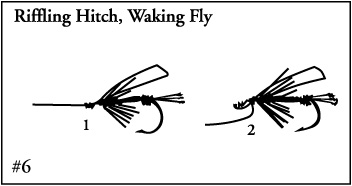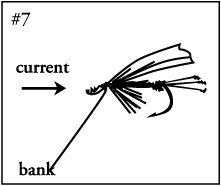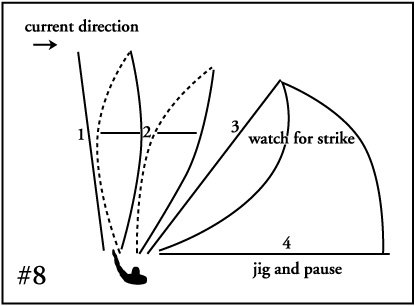Riffling Hitch, Waking Fly

The riffling hitch provides a surface struggling-and-waking action that simulates an injured baitfish trying to right itself. With this crippled action, fish are attracted to an easily caught meal.
This method is productive for both salmon and steelhead as well as trout and smallmouth bass. Whenever the fish are actively feeding at the surface, the riffled fly may be fruitful. At times of giant stonefly and golden stonefly egg laying flights, the riffle hitch affords an enticing action. Stoneflies commonly sputter along at the surface during egg-laying.
Simply, the riffling hitch is just a couple of half-hitches tied to the head of the fly so that the leader extends out at a right angle. Using stiff heavy tippet materials accentuates the fly’s action. The tippet can be tied to extend out on the right side, the left side, or the underneath side of the fly’s head. Each position furnishes a different action when fished across the current. Frequently, the most useful hitch is the one that directs the tippet out towards the bank side of the fly when the fly is directed upstream. This position intensifies the fly’s surface action. (See Diagram 6)

- Tippet is attached by an improved clinch knot.
- To re-direct the tippet, two half hitches are placed out at a right angle to the fly’s shank. These half-hitches are tied onto the fly’s head.
The preferred riffle hitch bank position in relation to both the current’s direction and the bank’s position is to have the tippet extend out towards the bank when the fly’s head is directed upstream. (See Diagram 7) The key to fishing the riffling hitch is to fish the fly under tension while it swings across the surface. (See Diagram 8)
- Cast directly across stream.
- Using several mends, slow or speed up the fly’s descent while maintaining some direct line tension to the fly.
- As the fly swings through the arch, watch for a possible strike. Many times interested fish may show themselves by boiling the surface.
- Fish the drop down area by jigging and pausing the fly to entice any reluctant fish. Next step-down and recast the fly; in this way the entire surface is fished. The choice of a fly pattern influences the fly’s waking action. Flies tied with Muddler minnow head styles or with stiff hackles and hairs generate more surface disturbances. Additionally, waking flies should be tied with buoyant materials to help keep them afloat.



© 2025 The Gale Group, Inc. All rights reserved.
© 2025 Perigee Learning LLC. All rights reserved.
LoveTheOutdoors.com is owned and operated by Advameg, Inc. © 2025 Advameg, Inc.
Camping Adventures • Dutch Oven Cooking • Sports Knots
Fly Tying • Freshwater Fishing • Fly Fishing

